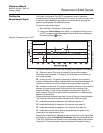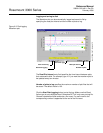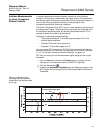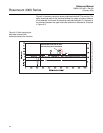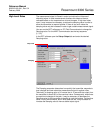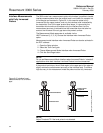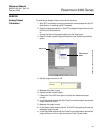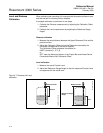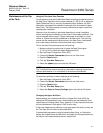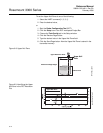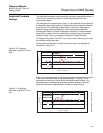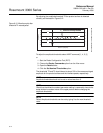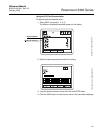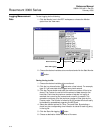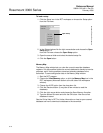
Reference Manual
00809-0100-4811, Rev CA
February 2006
6-11
Rosemount 3300 Series
Disturbances at the Top
of the Tank
Using the Trim Near Zone Function
For transmitters using the Guided Wave Radar technology the performance In
the Near Zone (referred to as the region between 0-1.6 ft (0-0.5 m) below the
Upper Reference Point) is normally somewhat limited. However, the 3300
transmitter is equipped with software functionality that minimizes the Upper
Dead Zone. The factory setting is normally sufficient and doesn’t need to be
repeated after installation.
However, since the setting is optimized depending on actual installation,
further trimming may be necessary in the case of unfavorable conditions. This
may for example be the case if a Single Lead probe is mounted in a small
nozzle, or if there are disturbing obstacles in the Near Zone. The trimming
means that the measurement performance in the Near Zone is maintained
even under these conditions and prevents false echo indication.
To trim the Near Zone perfomance do the following:
1. Make sure that the product level is below the Near Zone region
(0-1.6 ft (0-0.5 m) below the Upper Reference Point).
2. Start the Radar Configuration Tools (RCT).
3. Choose the Device Commands option from the View menu.
4. Open the Details folder.
5. Click the Trim Near Zone option.
6. Select the Update option and click the OK button.
NOTE!
The Trim Near Zone function should only be used for reducing impact from
constant disturbances. It is not suitable for occasional disturbances.
To reset the transmitter to factory settings do the following:
1. Start the Radar Configuration Tools (RCT).
2. Choose the Device Commands option from the View menu.
3. Open the Details folder.
4. Click the Trim Near Zone option.
5. Select the Reset to Factory Settings option and click the OK button.
Changing the Upper Null Zone
Measurements are not performed within the Upper Null Zone (UNZ). By
setting the UNZ parameter to zero, measurements can be performed in the
region close to the flange (Near Zone). However, it is very important that there
are no disturbances in that region if UNZ is set to zero.
If there are measurement problems in the upper part of the tank you may use
the Trim Near Zone function as described above.
If the desired measurement range is below the Near Zone, or if disturbing
objects are located below the Near Zone, the Upper Null Zone parameter can
be used to avoid measurements above a certain level.



